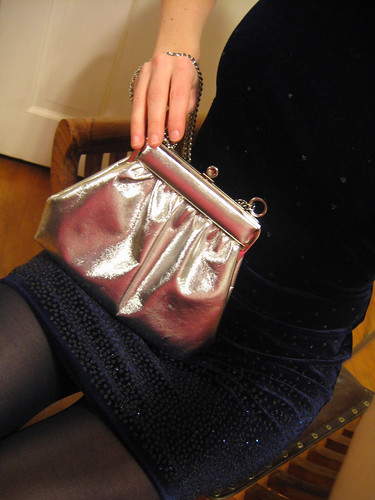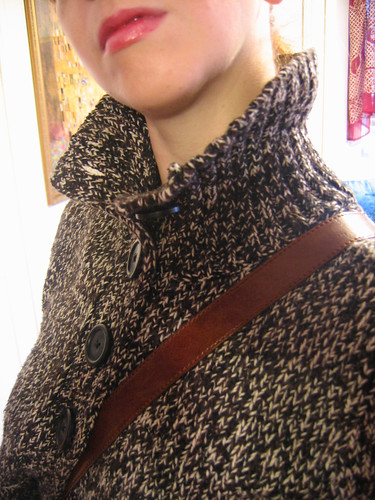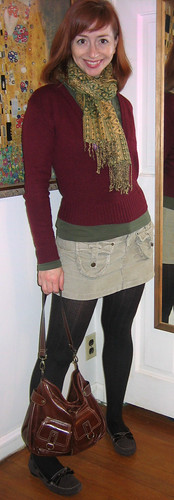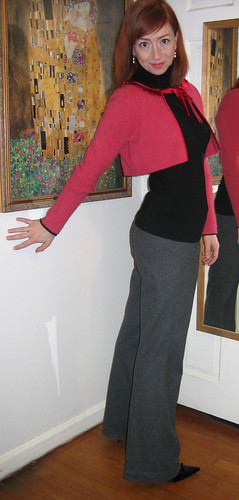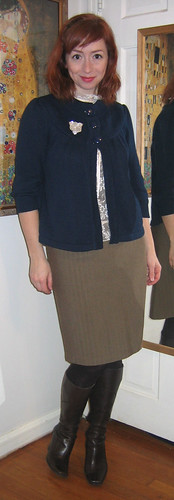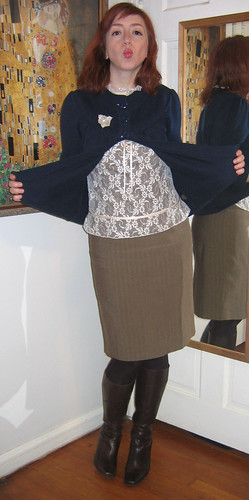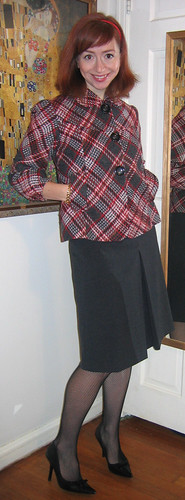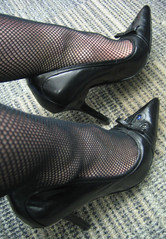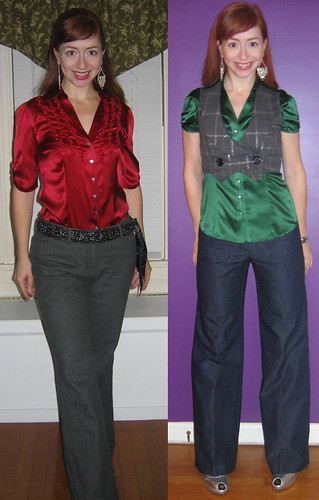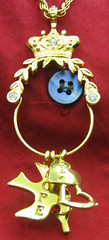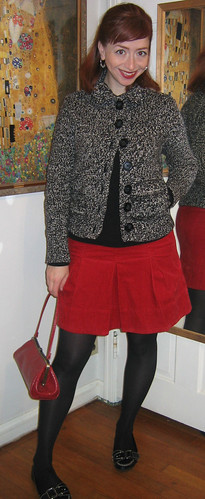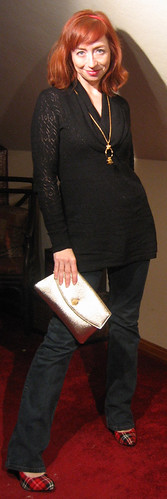I’ve never taken a photography class. I understand the basics of how a camera works and I am a bit artistic, so, through trial and error, I’ve developed the best techniques for photographing my outfits. My bag of tricks includes a tripod, use of camera settings, careful background selection, and manipulation of lighting.
Equipment. My camera is a Canon PowerShot A95. It’s a few years old, and you can no doubt find one today that is far superior for the price I paid. If you’re looking for a new camera, the key features I use on mine are: the flash (super bright), indoor setting, outdoor settings, adjustable exposure, and the timer. The next camera I get will have all these features, and a remote!
The other key piece of equipment is a tripod. It will only set you back $20 and you no longer have to worry about your camera slipping off that tower of precariously stacked CD cases. My tripod is a basic model with adjustable legs and a level. I find the level handy when I photograph outside, on bumpy ground. You may want to consider a
Gorillapod. The three short legs wrap securely around just about anything. I may purchase one for travel.
 Camera Height
Camera Height. Camera height is a personal preference. Whatever feature is at lens level will be emphasized. I like to position my camera as high as possible (within the tripod’s limits) because that most closely approximates the view I see in the mirror. It ends up being roughly chest height. (As I’m rather small on top, a boob-height camera is a plus.) Placing a camera above your head (as shown left) makes your head look big and your body small. This is an interesting technique, and it places a nice emphasis on the eyes, but it’s difficult to see outfit details. Many people on
Wardrobe Remix place their cameras at about 36” off the floor. For anyone self-conscious about their hips, this can place an unwanted emphasis on the butt and thighs, but it does make your legs look longer. A camera placed at a height of below 36”, will make the average person look like a
looming giant.
Another note on camera height (and very closely related to posing, the subject of my second
Photographing Your Outfit post), is that you will also want to consider the positioning of your head relative to the lens. I dislike the way my face looks when photographed
from below, so I tend to tuck my chin so that my face is straight on to the chest-height camera. If you have any fat at the jawline, though, this can create a double chin. Your aim is to photograph your outfit, of course, not your mug, but vanity causes most of us to want our face to look good too. I advise experimenting with different head positions and camera heights until you find a combination that pleases you.
Flash. The flash is almost always your friend. True, your clothing will photograph its truest outside, in even, natural light, but that’s hard to find. Even on a perfectly overcast afternoon, you will have some shadows (and they are usually on your face). For the amateur photographer, taking indoor photos, I recommend using the flash every time. It brings out sparkle and colors and, best of all, blasts wrinkles, blemishes, and dark spots from your face. I sometimes even use the flash outside, during the daylight. I go through a lot of batteries, but it’s worth it. Experiment with your camera to find the best distance to stand from the flash. You want to be illuminated, but not obliterated. If you’re still unhappy with the way the flash renders your outfit’s clothing or texture, consider taking detail shots without the flash.
Special Settings. Again, I don’t claim to know the intricacies of my camera’s innards, but I do know how to spin the magic dial at the top to get the best photos. Indoors, I use the indoor setting and the pictures mysteriously come out better! I’m savvy enough to know that the camera shutter is left open longer on the indoor setting, to account for the reduced light, but otherwise, the working of the setting really is a mystery. Outdoors, I use the setting with a picture of a mountain and a cloud. I assume this is some sort of outdoor setting – and it allows me to adjust for things like daylight and cloud cover.
Timer. Unless you have a photographer or a remote, you simply cannot take decent pictures of yourself without using the timer. I see many “in the mirror” shots on Wardrobe Remix, but they are always inferior to non-mirror shots. Using my timer and tripod, I frame the shot, press the shutter, and run to position myself while the timer beeps. After each shot, I run back to the camera and check the results. I usually have a head or leg out of the first attempt, but adjust by the second. My timer can be set for 2 or 10 seconds. I prefer the 10 seconds so that I can do things like readjust my jewelry (it falls askew when I lean over the camera, inspecting the last shot), fix my hair, and shoo the kitties away before the shutter clicks again.
 Exposure
Exposure. I’ll admit, I was afraid of the exposure settings at first. Only real photographers adjust the exposure and I’m just an amateur. After some dismal results, though, I learned to manipulate the exposure. There are two instances where I find it necessary. The first is with very dark outfits. I usually turn the exposure up (sometimes as high as +1) to better capture the details of a dark or all black outfit, like the photo to the right. This means my face is over-exposed, but, despite my vanity, the outfit comes first. I’ll also adjust the exposure when I take a photo of a dark outfit against a light background or a light outfit against a dark background. Because I use the timer, the camera will automatically set the exposure to the scene without me in it. If I don’t manually adjust it, I’ll end up
glowing against a dark setting or smoldering against a light. I usually take a few photos, with varying exposures, before I get it right. If I had a remote, I wouldn’t have a problem stepping into a contrasting background.
 Background
Background. So, if I have so much trouble with the exposure when I stand against a contrasting background, why do I do it? Because taking a
photo of your white outfit against a white background is not going to show your clothing off well. I have four walls in the house that I generally take photos in front of: white (corner), purple, orange, and green. For most outfits, I use the white corner. If I’m wearing any white, though, I tend to use the green or orange walls. If I’m in all black, I prefer the purple wall because, when I turn the exposure up, the wall will not “glow.” I often pose in front of the orange or green walls to contrast with the colors of my outfits or, alternatively, to pick up colors that might be more subtle in the white corner.
-
White corner: most outfits, never white
-
Purple wall: all black, some black, contrasting outfits
-
Orange wall: light colored outfits, contrasting outfits, outfits with some orange in them
(I should also note that I like using the orange wall because the surrounding orange walls [it’s a hallway] make the light a flattering, warm color)
-
Green wall: light colored outfits, contrasting outfits, outfits with some green in them
Admittedly, the lighting is best in the white corner (because the light bounces off the white walls AND the mirror), but I sometimes need to mix it up to capture the outfit’s details.
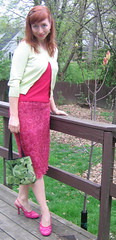
Outside, I’d love to use more locations, but the deck has been the only place with the privacy and level surface I prefer. I can get a variety of backgrounds there, from the
dark overhang to the brightly lit yard.
Lighting. I love the flash, but it works even better if the location is already adequately lit. I turn on every possible light that might influence the shot. The white and purple walls are both in our guest bedroom and the overhead fixture lights the room well. The orange (hallway) and green (dining room) walls are not well lit, so I turn on lights in adjacent rooms to brighten the shot as much as possible. The flash should assist the lighting of the picture, not be the sole source of illumination.

Sometimes, I take shots without the flash because I don’t like the way the colors or textures turn out. I took
this picture in a room with an overhead light and a halogen light placed on the floor. My face is unattractively shadowed, but the outfit’s subtleties are properly rendered. Our attic bedroom is lit with a strip of halogen lights. With one of them aimed at me like a spotlight (see left), I have absolutely no need for a flash!
Outside, an overcast day provides the best illumination. It is an even, gentle light. If the day is sunny, take your photo in the shade. You may have to adjust the exposure, but the result will be truer than a photo taken in the blinding sun (and you won’t be squinting). If taking a photo in the shade, be sure that you don’t have a sunny patch in the background. You’ll just end up as a
silhouette.
For all of you who, like me, photograph your outfits on a regular basis, I hope I’ve been a help. The key is proper equipment and a willingness to experiment. I didn’t start this blog myself until I finally had a tripod. Many of my early photos were awful, but I learned by doing until I was happy with the results. Happy photographing!
Expect a follow-up post,
Photographing Your Outfits – Posing, soon!
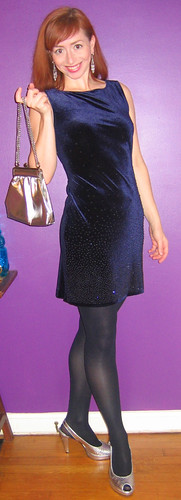 Navy velvet tank dress with beading, thrifted. Navy tights, Hue. Silver peeptoes, BCBG Girls. Chandelier earrings, some department store. Silver purse, thrifted.
Navy velvet tank dress with beading, thrifted. Navy tights, Hue. Silver peeptoes, BCBG Girls. Chandelier earrings, some department store. Silver purse, thrifted.
